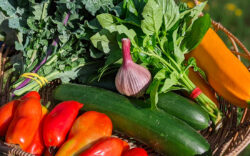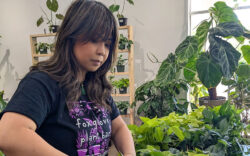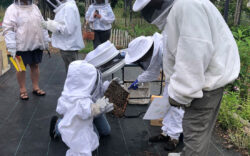Repotting Plants: Indoor and outdoor plants kept in pots may need repotting now. Carefully remove plants from their pots and check the root to soil ratio. If there are more roots than soil, consider moving that plant to a bigger pot. There are some exceptions—some varieties like small containers. For example, spider plants grow better when they’re a little pot-bound. Unlike in April, if life gets busy, your potting station can chill for a few days. Indoor plants left outdoors overnight in May won’t automatically die. Whether you need a bigger pot or not, consider refreshing everyone’s soil, adding a layer of compost or soil on top.
Up Your Watering Game: Get out those water hoses and watering cans, it’s time to make it rain. Both indoor and outdoor plants will need more water as the degrees tick upwards. Trees planted during the fall or winter require irrigation the first year to become established. Try to get a standard routine in place. Maybe it’s a meditative watering at the beginning of the day. Maybe you and your child can water every Wednesday and Sunday together. Maybe you’ll be like me and wander around the yard at 6 p.m., beer in one hand, hose in the other. Don’t water every green shoot every day. If you frequently drown your plants, try dividing your yard into fourths and focus on watering one quarter per day.
Weeding Time: May turns the sweet, inoffensive weeds of spring into the hellish, pervasive and easily reanimated weeds of summer. Spring weeds like dead nettle provide flowers for pollinators, and easy-to-pull chickweed and watercress are great treats for my chickens. Summer weeds, like bermuda grass and crabgrass, require effort to keep in check. Pull out what you can, where you can. Put down barriers, like cardboard on top of mulch, to slow their growth. Try shading out areas by planting more robust varieties that can out-compete those weeds. This is a good month to tackle poison ivy as well. The vines are still fairly young but large enough to see, and they haven’t set fruit yet. I usually wait until it rains, suit up in plastic gloves and an old rain jacket, and pull as much poison ivy as I can fit in a few garbage bags. Weeding isn’t a zero sum game for me; it’s about slowly reducing the footprint of these invasives.
Check for Ticks: Check dogs, cats, kids and adults. Ticks often ride deer into neighborhoods, so you don’t need a backcountry hike to find the parasite. Deer ticks (black or brown and black) can carry Lyme disease, and lone star ticks (dark with a small white dot) carry Heartland virus. Wear long pants, spray ankles and shoes with bug spray and check your body for any little boogers that try to hitch a ride.
Garden Planning: May is a great month to start mapping out what you’d like where, budgeting for upgrades and to start collecting plants for your eventual makeover. Garden planning can go sadly awry when there aren’t any leaves on the trees—are you sure that spot gets eight hours of sunlight? You can save money by buying some accessories at the end of the summer, when prices tend to drop.
Support Your Hobby: Vines like cucumbers, indeterminate tomatoes, climbing beans, clematis or morning glories need their trellises now. Taking too much time to put your supports in place can lead to some veggies, like cucumbers, contracting diseases or attracting pests from the soil. Spiking supports later in the season also could injure needed roots. Trellises for naturally vining plants help them produce more flowers and more fruit.
Start Composting: Keep Athens-Clarke County Beautiful supplies plenty of information on how to compost on the accgov.com website. There’s a bin for purchase and plans for different DIY bins available on the website. Like gardening, composting is about gaining experience, making mistakes and figuring out what works best for you. Late spring is a good time to attack this project because, with some care and attention, you could have usable compost by the fall.
Like what you just read? Support Flagpole by making a donation today. Every dollar you give helps fund our ongoing mission to provide Athens with quality, independent journalism.










